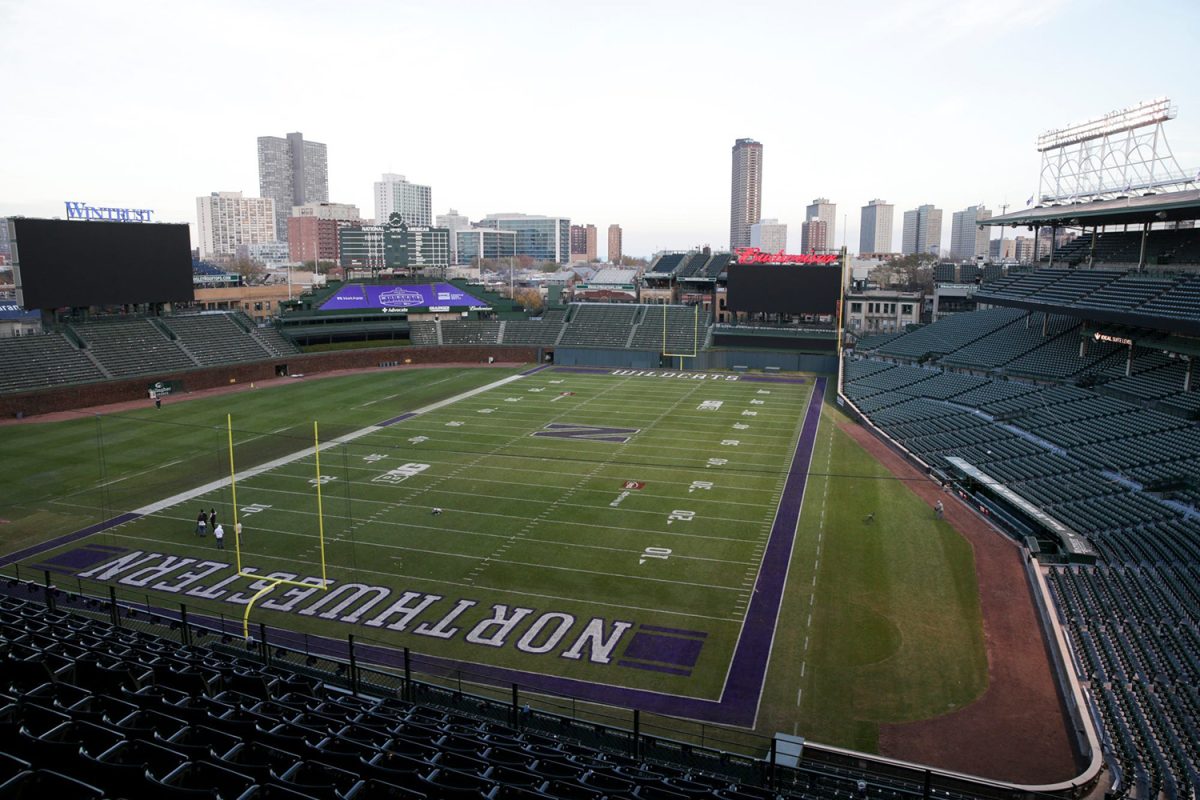Chicago’s historic Wrigley Field will host an early-November matchup of Midwest rivals, but there won’t be any baseball taking place.
Instead, the 6-2 Iowa football team will take on 4-4 Northwestern in the second-annual ‘Wildcats Classic,’ just the third time a football game has been played in the 109-year-old stadium in the past 14 years.
“I’m pretty excited because I’ve never played in a baseball stadium before,” Hawkeye wide receiver Diante Vines said. “I’m not a Cub fan, though — it’s still Yankees all the way.”
Northwestern first played at the Friendly Confines in 2010 when the Wildcats fell to in-state rival Illinois, 48-27. The contest marked the first time the pigskin was present at Wrigley in nearly 40 years. The lopsided result was marked by an unusual game format, as each offense drove westward to the same end zone because the end zone on the other side of the field was dangerously close to the iconic ivy and brick outfield wall.
Northwestern’s inaugural ‘Wildcats Classic’ game was during the 2021 season when Northwestern lost, 32-14, to the Purdue Boilermakers. That time around, both end zones were used, and then-Purdue quarterback and current Oakland Raider Aidan O’Connell threw for 423 yards and three scores.
Iowa head coach Kirk Ferentz said it’s a privilege to play inside Wrigley, but it comes with some hurdles. One of these obstacles is that the Hawkeyes and Wildcats will share the same sideline. He even joked with NCAA official Ron Snodgrass that the referees will have a “real challenge” managing the clock on Saturday with sideline calls from the same place.
“Playing on the same sideline is a unique challenge,” the head coach said. “Baseball locker room, single file, up and down steps, all things like that when you have 70 guys you’re trying to get through. There will be some challenges – signal stealing, subbing from one end of the field to the other.”
To prepare for the matchup, the iconic Wrigley Field Marquee was painted Wildcats’ purple instead of its usual Cubs’ red, and other features in the stadium were changed to recreate the atmosphere of a home Northwestern game.
This isn’t the first time Iowa has played in the Windy City. In 2007, Iowa kicked off its season by beating Northern Illinois, 16-3, in Soldier Field, home of the NFL’s Chicago Bears. The contest was highlighted by Iowa running back Albert Young’s 145 rushing yards and one touchdown performance.
Five years later, the Hawkeyes returned to the stadium on the lakefront, taking down the Huskies, 18-17, in a contest decided by another solid performance in the run game. This time, it was from Iowa RB Damon Bullock and his 150 yards on the ground.
Iowa is also no stranger to playing at baseball stadiums in recent years. Iowa beat Boston College, 27-20, in the 2017 Pinstripe Bowl at Yankee Stadium in New York City. Even still, the Friendly Confines poses its own weather-related challenges.
“I’ve heard some things from a few people that it gets pretty windy [at Wrigley Field], so I’m not looking forward to that, but you just got to make the best out of the opportunities,” Iowa second-year placekicker Drew Stevens said.
Like many stadiums of the early to mid-20th century, Wrigley Field was used as a dual-purpose arena with football during the early years of its existence. It was the home of the DePaul University Blue Devils — now without a football program — and the Bears, who played all their home games at the field from 1921 to 1970. At the time, the field dimensions ran north-south instead of east-west.
After the NFL-AFL merger in 1966, league officials wanted teams to play in stadiums built to hold up to 50,000 people, and with a capacity of just over 41,000, Wrigley didn’t make the cut.
Though it has been several decades since a college team shared its football field with a baseball organization, the practice was often featured in the professional ranks. The Raiders and MLB’s Oakland Athletics shared RingCentral Coliseum—formerly the Oakland-Alameda County Coliseum, from 1968 until the Raiders relocated to Allegiant Stadium in Las Vegas in 2020.
The tradition of dual-purpose stadiums faded into the 21st century as NFL and MLB team owners began to build new, state-of-the-art facilities, such as Allegiant Stadium and SoFi Stadium in Los Angeles.
Even if the practice is not commonplace today, Ferentz still feels some nostalgia watching the pigskin thrown on the diamond. In his press conference on Tuesday, he recalled watching then-Minnesota Vikings head coach Bud Grant lead the Purple People Eaters of the 1960s and ’70s inside Metropolitan Stadium.
“We’re going to make it go,” Ferentz said. “It will be a thrill.”



